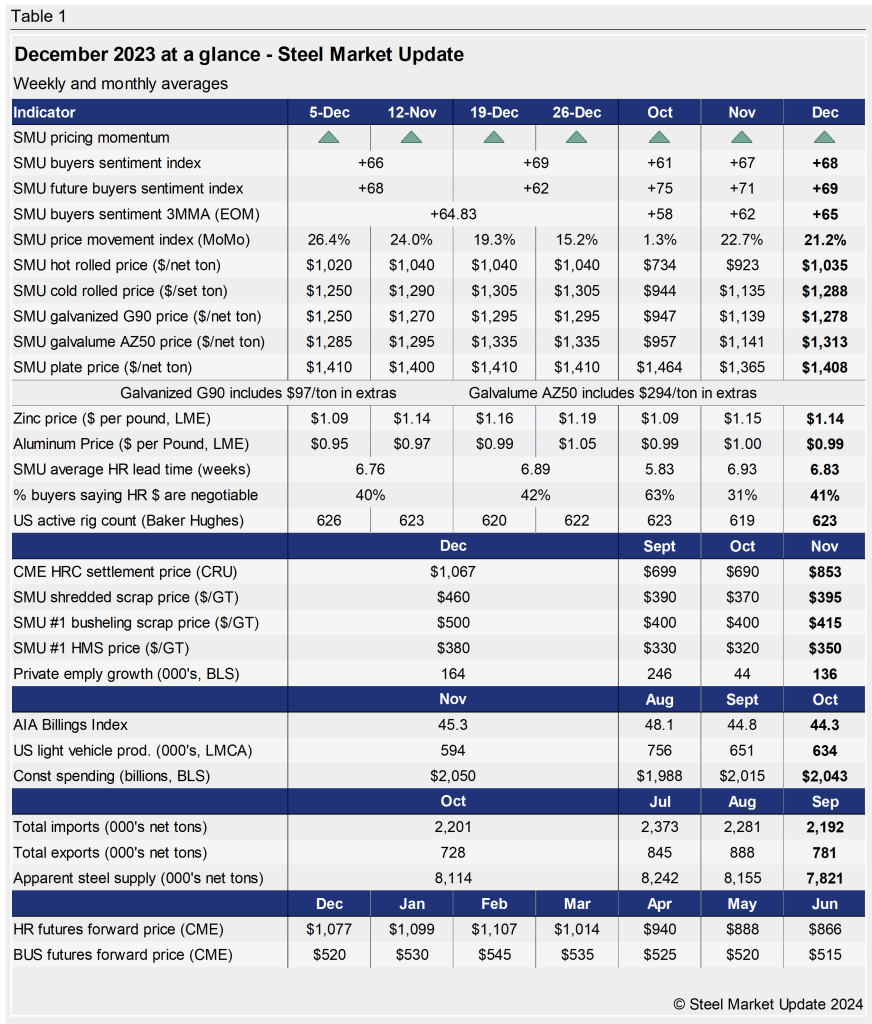Market Data
January 9, 2024
SMU's December at a glance
Written by David Schollaert
Steel prices continued to move higher last month on the back of repeated mill price increases after tags reached a 2023 low of $645 per ton in late September. Hot-rolled coil (HRC) prices ended December at an average of $1,035 per ton ($51.75 per cwt), rising by $112 per ton during the month.
The SMU Price Momentum Indicator for sheet products continued pointing Higher throughout December after shifting from Lower in September. The trend remained in place as tags kept rallying in response to mill price hikes throughout the last month.
The Price Momentum Indicator on plate, which had been pointing Lower since September, shifted to Higher, largely in response to mill increase notices at the close of November. The indicator remains Higher through December. Despite the improvement, signs of weakness due to waning demand persist.
Raw material prices have fluctuated somewhat but were again mostly sideways last month, except for scrap. Scrap prices improved on average in December, up between $60-85 per ton. Despite some movement midway through the month, zinc and aluminum spot prices were largely stable, remaining within historical levels. You can view and chart multiple products in greater detail using our interactive pricing tool here.
The SMU Steel Buyers Sentiment Index remained positive, edging up slightly during the month. Current Buyers Sentiment rose from +67 in November to +68 on average in December. Future Sentiment hovered at an average of roughly +69, down slightly from the prior month’s reading of +71.
Our Steel Buyers Sentiment 3MMA Index (measured as a three-month moving average) had been eroding over the past four months, falling to +58 in October, but recovered to +65 on average last month.
Hot rolled lead times averaged 6.83 weeks in December, down from 6.93 weeks the month prior. SMU expects lead times to hover around current levels, but market chatter suggests they could decline a bit more through January and further throughout the first quarter of 2024 as inventory management takes precedence at the end of the year. A history of HRC lead times can be found in our interactive pricing tool as well.
About 41% of HRC buyers reported in December that mills were willing to negotiate on prices, up marginally from roughly 31% in November as mills were still trying to move prices higher.
Key indicators of steel demand are still showing some signs of weakness overall and are nowhere near the bullish levels some had shown earlier in 2023. While there are some backlogs in the energy and construction sectors, demand for the early portion of 2024 remains rather controlled, especially as buyers appear to be pushing back a bit on the most recent round of mill price hikes.
See the chart below for other key metrics for December:








